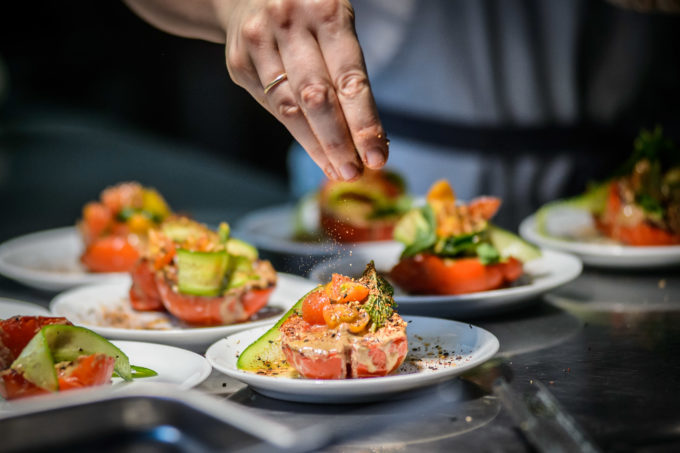

15 Questions with Sqirl’s Jessica Koslow
Since its inception in 2011, Sqirl has become synonymous with vibrant California cuisine, thanks to its signature jams, iconic brioche toasts, and sorrel pesto rice. With chef and owner Jessica Koslow at the helm, the quaint Silver Lake breakfast-and-lunch spot has become a beacon– and it’s sprouting wings (with a recent cookbook, a forthcoming fast-casual outpost, and a full-service dinner restaurant, Tel). We sat down with Koslow to chat about the make-or-break moments along the way, her vision for Tel, and what she has in store for us next.
Resy: What was your ambition for Sqirl?
Jessica Koslow: I started Sqirl as a jam company, and it was a pretty honest process, in terms of asking myself what I wanted.
Coming from a background as a pastry chef, and then moving to LA and, for the first time, experiencing produce year-round, I realized how fortunate I was. Marry that with the technique I was learning in the South and jam-making, and, ultimately, the evolution to the cafe made sense.
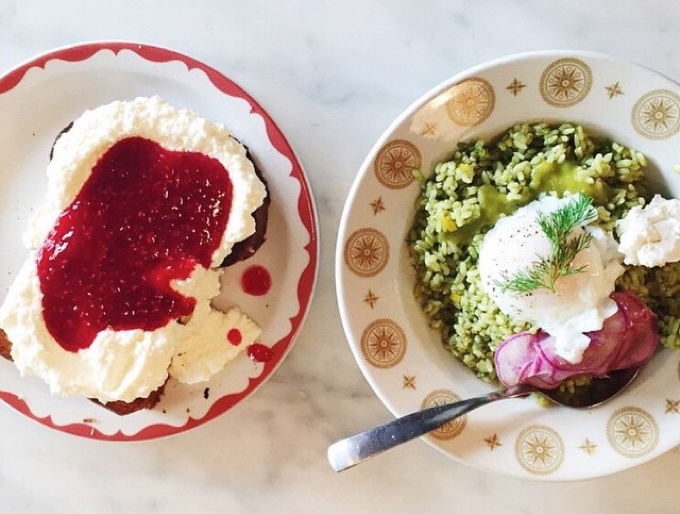
Iconic Sqirl dishes, ricotta toast and sorrel pesto rice. Photo Credit: Instagram/@sqirlla
Was there a make-or-break moment that made you pursue Sqirl more seriously?
When you are just a jam company, you can hide behind your jars, because you’re not really the face of anything. You’re not putting yourself out there the way that you would if you had a 7-day-a-week service, where the doors are open and people are coming in. So, I had this location and thought, ‘I live in Silver Lake and this is my community. And the thing I’m missing, more than anything, is a place where anyone can come and feel like they are part of the community.’
People would just go to Intelligentsia for coffee, and that was [the place] we all thought was the community space for daytime. As someone who had worked in fine dining and then also in Australia in a very breakfast-and-lunch-centric area of Melbourne, I thought, ‘This is my opportunity to take what I’m doing, which is Sqirl and jam, and transition into something that is a breakfast-and-lunch place for the neighborhood.’ So, that was really the moment I thought– ok, I’m willing to open my doors and meet people, say hello, and be an essential part of the day. And it was a really scary moment – but a really rewarding one.
It sounds like the evolution happened organically– the demand was there.
Yeah, it was never about [people said] “how will you make a profit? It’s a breakfast-and-lunch spot; there’s no alcohol.” This was the evolution of what I saw as important in my work, and somehow all those other things lined up.
You mentioned the novelty of having access to produce year-round – a stark contrast to cooking in the South. How does this access affect your process for recipe development?
The process of recipe development is two things: one is seeing what’s at the market, so we’re getting peak produce and putting it together – marrying fruits like lemon verbena or kumquats with chamomile, the way people put tomatoes and corn together. But, there’s another layer, which is technique. I could easily do a chutney with Santa Rosa plums and, instead of using dried fruit – which is how a chutney is traditionally made – fold in smoked strawberries. The technique is knowing how to smoke something and layer flavor.
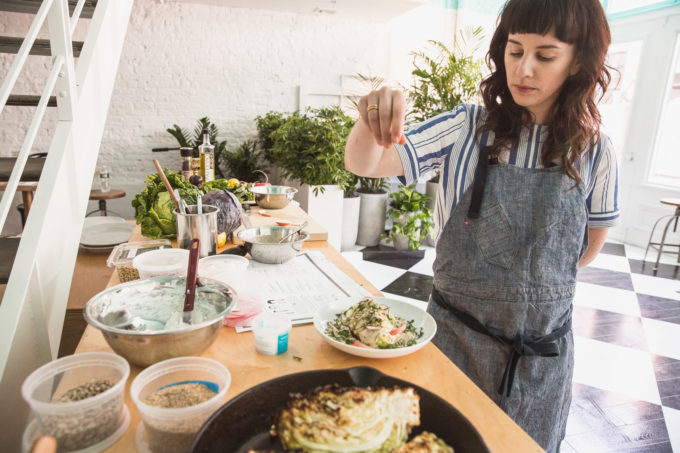
The Food Lab at South Street Seaport.
Much of that technique is attributed to your background [in fine dining], though your style has evolved. Are there certain elements that you continue to rely on as mainstay techniques from your formidable years?
In terms of specific techniques, I’m always reverting to lacto-fermentation (to create Umami-like flavors), as well as smoking and dehydrating. At Tel at South Street Seaport, we’re doing a burnt cabbage dish, and the cabbage itself will be finished with sauerkraut that has been dehydrated and then turned into powder. Those kinds of accents create texture – from the dehydrating and powder form to the flavor from the sauerkraut. That’s the trickery we tend to find ourselves in at Sqirl– layering flavor through fermentation and dehydration.
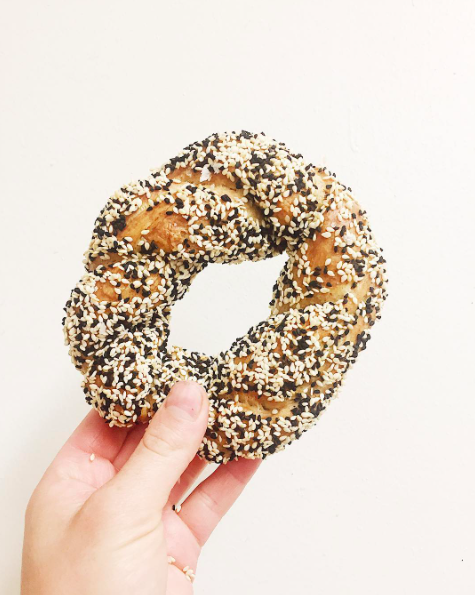
The pull-apart bagel Koslow is developing for her new Los Angeles restaurant, Tel. Photo Credit: Jessica Koslow/@prosciuttosnacks
Do you have a current food crush or fantasy food ambition– something you’re dying to master?
(laughs) So many things, it never ends! My fear is that I’m going to say it and then tomorrow I’m going to see it. I’m still always surprising myself and my chefs are always surprising me. The menu at Sqirl never stays the same, because it’s really important to push boundaries, and sometimes it works and sometimes it doesn’t.
We’re doing a version of a bagel for Tel [Los Angeles] that is twisted (it’s based on a Polish bagel) and pulls apart, like Armenian string cheese. It’s then oven-boiled and finished with a Montreal wash. And part of the flour for that bagel is actually a charcoal wheat, which we get in California. The seasoning – for a sesame bagel – is actually nigella (a Middle Eastern seed). It’s very New York, meets Montreal, meets Poland– everything is very layered.
At Tel, at the South Street Seaport, we are making Malala, a flatbread that is laminated with Cardamom ghee and finished with nigella. It’s flaky and pulls apart, like a croissant. It’s so insane. I don’t know how we’re going to stop people from asking for seconds, because it is so time-consuming to make– the labor of layering dough like that for 70 people a night. We’re going to need a lot of hands!
I’m also obsessed with Roman pizza, so I want to do something called “Salad Pizza”–a quick-service place that serves square pizza and chopped salads on top of each other.
I’ve become obsessed with the history, the backbone of something; so these dishes are not just based on…what I feel like creating. They’re based on layers of history and technique that have been peeled off to create the final product.
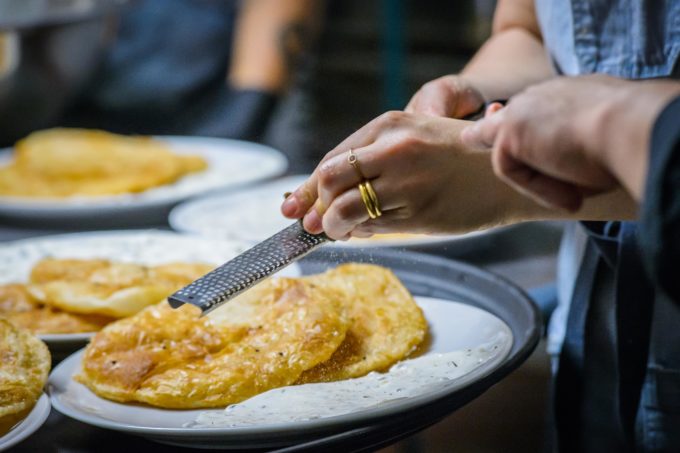
Chef Jessica Koslow’s Malala.
I know you’ve said that even if a dish has straightforward ingredients, nothing is just one step. What are some of the other tenets you live by?
I start at the end and work backwards. In the end, you have to put it in your mouth and be completely oishii– delicious. It has to be something more: vibrant and explosive, but also layered in texture. That is what I’m gunning for.
In terms of tenets:
- Texture: I’m a stickler for texture — I can’t just have a dish be all soft, I need crunch, too.
- Bite: What does that first bite taste like? That’s all the time we’ve got to capture a person. When I see the look of eyes lighting up, that’s when I feel like I’ve succeeded. I look for the eyes.
- Layering: That’s the most important thing! The major tenet — the layers of texture, color, technique, individual flavors — all add up to the “thing.”
- Point of reference: What is the original dish’s inspiration? I always recognize where a dish starts as the road leads elsewhere.
Israeli food is really having a moment. What inspired you to pursue Tel? Is it the natural next step from Sqirl?
Yeah, Tel is the next step for sure; Sqirl is evolving in its own space with Sqirl Away.
The word Tel is Hebrew, and it means a mound, or layers, of settlements– life forms created on top of life forms. So, this Tel is built on not only on my own personal (familial) history, but also my own professional history.
Tel is a new restaurant with a daytime component, which is an all-day quick service, and a 110-seat dinner restaurant. It’s a Jewish diaspora– an intersection of Jewish foods from all over the world, through a California lens (based on California ingredients).
Sqirl is a California restaurant, and it’s breakfast and lunch without barriers or boundaries; Tel is a little bit more focused on flavors, history, and technique– in its own way.
Jessica Koslow seasons dishes at Tel at the South Street Seaport Food Lab.
At Tel, what are five mainstay ingredients that you can’t live without?
- Pickled rosehips
- Crispy rice
- Cardamom ghee
- Turmeric millet jack – which is this crackerjack concoction we make, but with pressed millet.
- Smoked Santa Rosa plums
- Avocado seed tahini (we’re making tahini from saved avocado seeds).

Image courtesy of Sqirl.
Are there things you’re excited to experiment with on the East Coast that you don’t typically cook with in LA?
We’ve been following the Union Square farmer’s market to see what’s available. We’re doing this eggplant dish for Tel at South Street Seaport, and it’s exciting because there’s a bunch of really beautiful eggplants.
There’s a farmer, James Birch, who has a farm Flora Bella, which is based in LA, but he’s now living part-time in NY. So, we’re able to work with a farmer who has spent the last several years in California, and it’s been really exciting for us to be able to work with his produce on the East Coast.
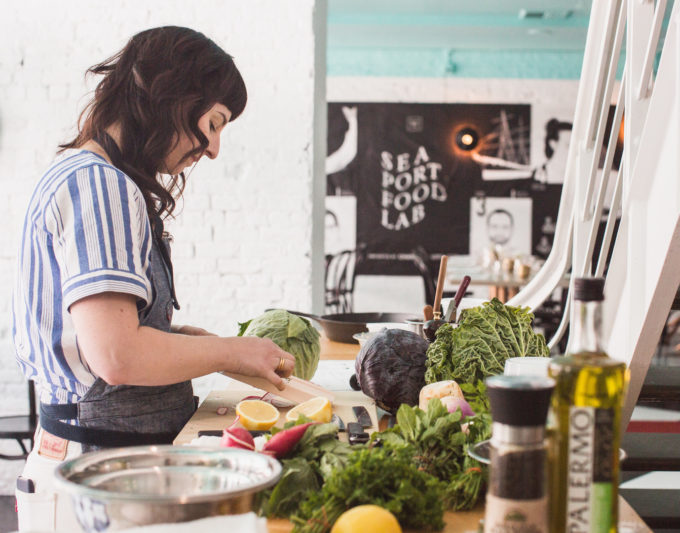
Chef Jessica Koslow preparing her menu for Tel at South Street Seaport Food Lab.
You always find such unique purveyors!
It’s friendships and relationships, and it’s really important to me to support James, because we’ve supported each other in LA. These are people who have given their lives to farming and the land, and they are supporting us as chefs and championing what we do. It’s like why you would choose to wear a certain designer – the same thing goes for produce. It’s the food that I want to eat, and it’s the produce I want to eat, and I want to share that with you!
It’s like a collection…
(laughs) It is a collection: Fall ’17! You know what’s funny? I’m up here in Northern California, because there’s a variety of apple that’s in Sebastopol called Gravenstein, and it doesn’t come down to Southern California. So we just flew up to Northern California, rented a jeep, and we are driving to pick them up so we can drive them down to LA.

Chef Jessica Koslow, pictured with Frank Falcinelli and Frank Castronovo (L–R)
at Resy & Frankies Spuntino Present the Franks Backyard Chef Series. Photo Credit: Meredith Jenks
If you could create alongside anyone, who would it be?
Oh my God, probably Michele Bras– old-school Michele Bras in the ’90s. I want to make a salad next to him and see how his mind works for a day. He’s got these new quick service concepts in France, and they’re very cool.
Are there cities you are inspired or enchanted by?
I’m always inspired by places in Japan, like Tokyo and Kyoto, just based on the severe and minimal approach to food, and how clean and vibrant the food can be.
I’m very interested in the Baltic and Dalmation Coasts, because of how fresh the ingredients are and how olive oil and tomatoes play a big part. And, obviously, Israel and Poland.
And, of course, I’m very interested in the food of Los Angeles, and how we are evolving the food of LA.
What are some of your favorite restaurants in LA and beyond? Are there places where you are a regular?
I am a regular at this place called Mhzh in Los Angeles: it’s a small, hole-in-the-wall Israeli restaurant in Silver Lake that’s so delicious. They use a coal-burning oven. The vibe is good, and the food is great.
There’s a Japanese restaurant I love called Shibumi, also in Los Angeles. It’s a Japanese bar. The chef lived in Japan for many years, and he worked under Nozawa (he is a master). If this place were in New York, it would be packed every night, but because it’s in LA, it’s just chill. Those are my two places in LA, which I truly have to take everyone to when they come to town.
In Paris, I love Le Baratin. It’s from a husband-and-wife duo: she’s in the kitchen, he’s on the floor. He has some of the best wines on the menu – by the glass – just because he wants to drink them. There’s a huge menu that hangs from the wall, and they’ll bring it to your table and don’t look at you if you can’t speak French. Le Baratin is a special place.
And also that little pincho bar in the Boqueria in Barcelona. Mostly humble places, where the chef is there and you feel the heartbeat of the owner. I think that’s really important: feeling the heartbeat of the owner.

Sqirl’s namesake jams. Photo Credit: Instagram/@sqirlla
What’s been the most surprising discovery with Sqirl?
One of the things that has been amazing about Sqirl is the lack of restrictions. I just got back from a trip, and I saw crispy rice [a signature Sqirl dish] on a menu in Charleston, and that is an indicator of the freedom that Sqirl has. It shows that what we are doing is resonating, and people are listening!
There’s so much joy in the fact that we have the freedom to do a pancake, but instead of being a normal pancake, it’s made with cactus flour and has pudding on top of it. And, it’s one of our best-selling breakfast items! That freedom is power, and it’s been a really incredible experience to realize that it’s real.
Discover More


